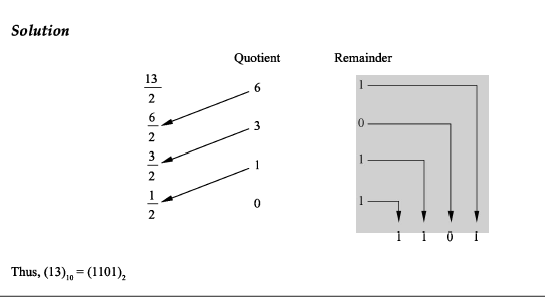Binary Number System
Binary Number System:
The number system wit base(or radix) two is known as the binary number system .Only two symbols are used to represent numbers in this system and these are 0 and 1. These are known as bits.
Decimal to binary conversion :
Any decimal number can be converted into its equivalent binary number. For integers ,the conversion is obtained by continuous division by 2 and keeping track of the remainder, while for fractional parts, the conversion is affected by continuous multiplication by 2 and keeping track of the integers generated .
Example: Convert (13)10 an equivalent base-2 number
For Fractional number
Example: Convert (0.65625)10 to an equivalent base-2 number
Example: Express the 25.5 decimal numbers in the binary from :
Binary to Decimal :
Any binary number can be converted into its equivalent decimal number using the weights assigned to each bit position.
Example: find the decimal equivalent of the binary number (1 1 1 1 1)2
Binary to octal:
Binary numbers can be converted into equivalent octal numbers by making groups of three bits starting from LSB and moving towards MSB for integer part of the number and then replacing each group of three bits by its octal representation.
Example: Convert (1001110)2 to its octal equivalent
Solution : (1001110)2 = (001 001 110)2
= (1 1 6)8
Binary to Hexadecimal :
Binary numbers can be converted into the equivalent hexadecimal numbers by making groups of four bits starting from LSB and moving toward MSB from integer part and replacing each group of four bits by its hexadecimal representation.
Example: Convert the following binary numbers to their equivalent hex numbers.
(a) 10100110101111
Solution: (10100110101111)2 = 0010 1001 1010 1111
2 9 A F
(10100110101111)2 =(29AF)16
For fractional part:
For the fractional part, the above procedure is repeated starting from the bit next to the binary
point and moving towards the right.
(b) (0.00011110101101)2
Solution: (0.00011110101101)2 = 0.0001 1110 1011 0100
1 E B 4
(0.00011110101101)2 = (0.1EB4)16






Comments
Post a Comment